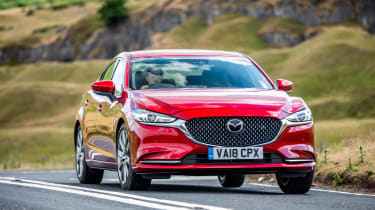Mazda 6 (2012-2022) - Engines, performance and drive
It's petrol power only for the Mazda 6, while top-notch handling boosts its credentials as a great driver's car

Just so you know, this is an older review of the 2012-2022 Mazda 6. If you are interested in information about a used Mazda 6, or news about the latest Mazda models, please follow the links provided.
From the company that makes the marvellous MX-5 roadster, you’d hope the Mazda 6 would be a sporty and satisfying car to drive. And you won’t be disappointed. In giving it a driver-focused character, Mazda has built something that feels more agile than any crossover of SUV – although mindful of its market, this doesn’t mean compromise elsewhere.
A criticism of earlier examples of the Mazda 6 was that the ride was perhaps a bit too firm and sporting. But far-reaching detail revisions in 2015 cured this for the mainstream versions: now, it’s only the Sport Nav that has a taut ride, which means it can fidget around town over bumps and potholes, but does still smooth out at speed.
The benefit of this sporty suspension is excellent handling across all versions of the 6. Turn-in is sharp, there’s plenty of grip (particularly with the Sport Nav’s 19-inch wheels) and feedback through the steering is accomplished. The 6 is a great driver’s car and owners seem to really rate its talents behind the wheel.
Used - available now

2023 Audi
Q4 Sportback e-tron
54,526 milesAutomaticElectric
Cash £23,363
2022 Kia
Niro
18,315 milesAutomaticPetrol1.6L
Cash £17,900
2023 Nissan
Juke
40,858 milesManualPetrol1.0L
Cash £12,287
2022 Volkswagen
T-Roc
36,779 milesAutomaticPetrol1.5L
Cash £18,600Mazda's 2016 update for the 6 included an innovative new system called 'G-Vectoring'. Essentially, it subtly adjusts torque delivery according to steering angle with the aim of providing a more stable and comfortable driving experience - different to more grip-focused torque vectoring systems. While various graphs and videos by Mazda show it working, we were unable to really detect it from behind the wheel - although it could benefit passenger comfort on long drives.
The only omission in the Mazda 6 engine range is a truly sporty engine to make the most of this talented chassis - the closest you'll get is the 2.5-litre four-cylinder introduced with the 2018 update, which has 191bhp, although that's still not enough to overpower the chassis.
All Mazda 6 models come with Smart City Brake autonomous emergency braking as standard. It’s a useful safety aid, although in town, owners are more likely to appreciate the convenient hill hold assist function.
Engines, 0-60 acceleration and top speed
With the 2.2-litre SkyActiv-D diesel engine now discontinued, it falls to the 2.0-litre SkyActiv-G petrol unit to pick up the Mazda 6's core customers. It's offered in two power outputs: 143bhp or 163bhp.
The 2.0-litre SkyActiv-G petrol engine has an unusually high compression ratio, again for efficiency and power. Both versions produce their maximum power at a heady 6,000rpm, and don’t deliver their identical peak torque of 213Nm until 4,000rpm. Good job the gearbox is as snappy as you'll need to work it.
The two petrol cars serve up similar performance; it’s only if you frequently use high revs that you’ll feel the benefit of the extra power. Most drivers won’t, because while the 163bhp version is a smooth and effervescent engine, it’s rather vocal and prominent when revved hard. This is the sort of noise you wouldn’t mind in an MX-5, but isn’t really what you expect from this class of car. The low-power petrol engine is offered with the six-speed automatic option as well.
A new addition for 2018 was the 2.5-litre Skyactiv-G 194 petrol. This has 191bhp and comes with the six-speed gearbox as standard. It's capable of 0-62mph in 8.1 seconds, making it the fastest model in the range.









